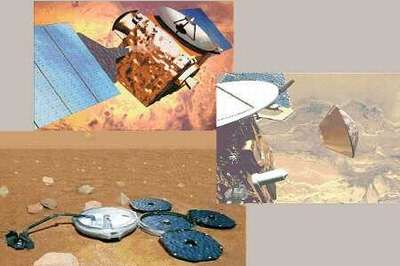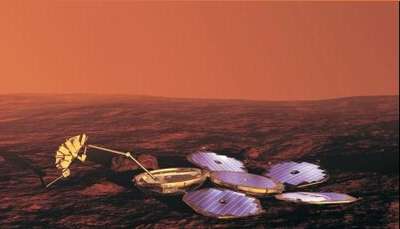Mon, Jun 02, 2003
First Ever European Visit To Red Planet
The wind stirs the dust around the former Soviet Cosmodrome at
Baikonur, in Kazakhstan. On the launch pad, a Russian-built Soyuz
rocket, tipped by a probe called "Beagle II." If all goes according
to plan, by December, the Beagle will have landed on the Martian
surface and begun looking for signs of primitive life on the Red
Planet.

An Interplanetary Mission At Bargain-Basement Prices
The European Mars mission is a study in economic space flight.
The Beagle II cost about $73 million to develop and build.
Management of the project has been largely turned over to private
industry and academia. Instead of launching the probe from the
European Space Agency's facility in South America aboard an Ariane
rocket, mission leaders decided to go to Baikonur and use the
less-expensive, more reliable Soyuz rocket. The launch will be
number 1,677 for the Soyuz program.
Total price tag for the European mission: approximately $300
million.

Red Planet - Cursed Planet?
"Mars is bad luck for space and a real difficulty for us," ESA's
science director David Southwood told Reuters. "If we were sailors,
I think we would be very superstitious about going to Mars."
Indeed, 20 of the past 30 missions to the Red Planet have ended in
something less than success. But Southwood told Reuters that
superstition won't impede the Mars Express project from putting
Beagle II on the surface. "Maybe there was life on Mars once in the
past? We are going to seek evidence of past life ... or indeed,
even micro-organisms that are alive now," Southwood said.

The European probe won't be alone in its trek to the Red Planet,
as Mars and Earth come closer than they've been for the past 66,000
years. There are two NASA orbiters circling the fourth planet and
two more NASA landers are slated for launch later this month. The
American landers contain rovers that are bigger and more
sophisticated than the UK-developed Beagle II. But only Beagle has
that onboard chemical laboratory specifically designed to look for
prehistoric signs of life.
More News
DETRESFA (Distress Phrase) The code word used to designate an emergency phase wherein there is reasonable certainty that an aircraft and its occupants are threatened by grave and i>[...]
"General aviation is at the forefront of developing and introducing innovative technologies that will transform the entire aviation industry..." Source: Kyle Martin, Vice President>[...]
Direct Straight line flight between two navigational aids, fixes, points, or any combination thereof. When used by pilots in describing off-airway routes, points defining direct ro>[...]
Aero Linx: Women in Corporate Aviation Women in Corporate Aviation support individuals seeking career advancement and professional development in the business aviation industry. Me>[...]
“We would like to thank the many volunteers that help throughout the year to pull off the event, as well as the several reviewers, judges, and SURVICE staff that provide team>[...]
 ANN's Daily Aero-Term (04.26.24): DETRESFA (Distress Phrase)
ANN's Daily Aero-Term (04.26.24): DETRESFA (Distress Phrase) Aero-News: Quote of the Day (04.26.24)
Aero-News: Quote of the Day (04.26.24) ANN's Daily Aero-Term (04.27.24): Direct
ANN's Daily Aero-Term (04.27.24): Direct ANN's Daily Aero-Linx (04.27.24)
ANN's Daily Aero-Linx (04.27.24) Aero-News: Quote of the Day (04.27.24)
Aero-News: Quote of the Day (04.27.24)





